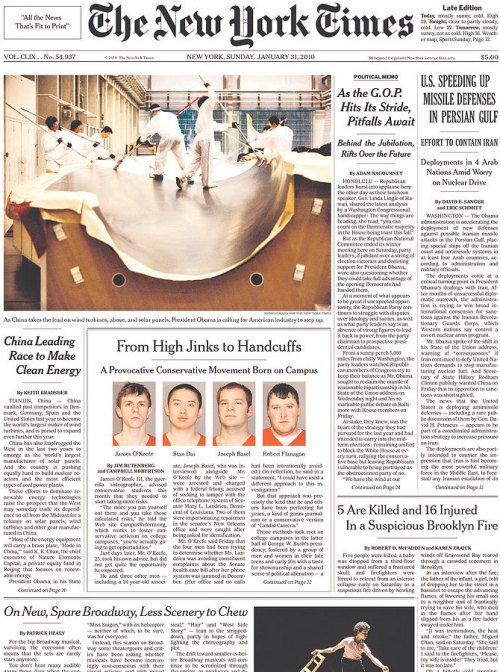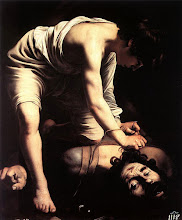By David Paulin
Lying, cheating, stealing -- all have been employed by gung-ho members of the Fourth Estate for the sake of the public's right to know. Indeed, reporters for top media outlets have masqueraded over the years as workmen, students, and even bar tenders in their effort to expose corrupt officials and misdeeds -- and to, of course, get a good story (and maybe some coveted journalism awards).
Well, who could imagine such journalistic shenanigans in light of the way the mainstream media is portraying James O’Keefe III, 25, the videographer who became famous for exposing Acorn, the liberal community organizing group.
O'Keefe is facing federal charges along with three young colleagues for allegedly attempting to "tamper" with (not "bug" as the Washington Post initially had gleefully reported) the phone system of Senator Mary L. Landrieu, a Louisiana Democrat. Two of them entered the senator’s New Orleans office pretending to be repairmen.
O'Keefe said the group was investigating whether Sen. Landrieu had been ducking constituent complaints last December by claiming her phone system was overloaded. He admitted to using poor judgment in respect to his investigative tactics.
So how does the New York Times portray O'Keefe and his young colleagues in a front-page story on Sunday? They're pigeonholed as being members of an exotic subculture - "conservative activists." And according to the Times, members of this subculture are willing to push the envelope in their determination to expose hypocrisy, foolishness, and other misdeeds among their targets – liberals.
The Times' headline sums things up along these lines: "From High Jinks to Handcuffs/A Provocative Conservative Movement Born on Campus." Oh, and by the way, the Times also published the mens' mug shots.
Indeed, the Times explains:
Those methods took root on college campuses in the latter half of George W. Bush’s presidency, fostered by a group of men and women in their late teens and early 20s with a taste for showmanship and a shared sense of political alienation — a sort of political reverse image of the left-wing Yippies of the 1960s. They studied leftist activism of years past as their prototype, looking to the tactics of Saul Alinsky, the Chicago community organizer who laid the framework for grass-roots activism in the ’60s, as well as those of gay rights and even Communist groups."
The Times, however, fails to mention something -- and that is that the tactics and flair for showmanship demonstrated by O'Keefe and like-minded conservative students share much in common with the mainstream media itself.
Consider some examples:
In 1978, the Chicago Sun-Times opened a sleazy bar operated by undercover reporters determined to expose rampant corruption in the Windy City. And soon enough, just as they'd expected, every petty official in Chicago was coming around with his hand open.
The Sun-Times' dynamite investigative series was described by an article in Time magazine:
Bribes flowed like beer...For just $10, the fire inspector was willing to ignore the exposed electrical wiring. For $50, the plumbing inspector "fixed" the leaky pipes, and for $100, the ventilation inspector overlooked $2,000 worth of necessary duct work. Jukebox and pinball purveyors not only offered kickbacks but showed the new management how to skim off profits.
The Sun-Times had hoped to snag a Pulitzer Prize for the series of articles it wrote about its bar, appropriately named the "Mirage." But some members of the Pulitzer board denied the paper America's highest journalism honor, believing its bar sting exceeded the envelope of acceptable journalism ethics.
Touching on the controversy, an article in the Milwaukee Journal pointed out that journalistic deceit – undertaken for the public good -- has a long tradition. At top news outlets, it pointed out, reporters have masqueraded as Congressmen, graduate students, and assembly line workers.
However, it noted that editors remain divided over whether such "masquerades" are ethical or unethical.
Such ethical hairsplitting can be the least of a news organization's problems when mainstream editors decide, like O'Keefe did, to push the envelope. In 1998, for instance, The Cincinnati Enquirer did an exposé on Chiquita Brands International Inc., portraying it as a heartless multinational. But the fruit company had the last laugh after it turned out that an Enquirer reporter on the story was involved in the theft of voice mails from Chiquita, or as the paper later admitted: "was involved in the theft of this information in violation of the law."
Among other things, the Enquirer paid Chiquita $10 million; fired the story's lead reporter; and published a front-page apology for three days in a row that said its story had ''created a false and misleading impression of Chiquita's business practices.”
All in all, the Enquirer's story sounds like one that would have made Saul Alinsky proud.
As for O'Keefe, there's no denying that he exceeded the envelope of his own advocacy journalism. Next time, he might try a safer story, like maybe following the Sun-Times' example and setting up a sleazy topless bar (with hidden cameras) near the U.S. Capital Building. Members of Congress would get discounted lap dances and booze.
Would such a sting operation be ethical? If you say no -- "unethical" -- then answer another question: Would you still want to watch the video captured by the hidden cameras?
O'Keefe and his colleagues, I'll bet, know the answer to that one.
This was originally published at The American Thinker.





No comments:
Post a Comment